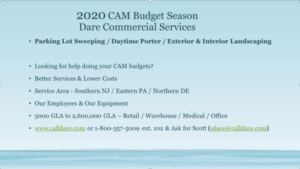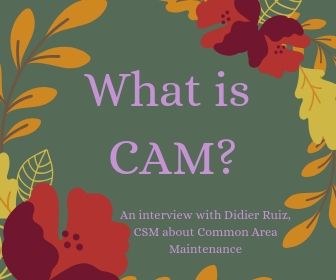What is CAM (common area maintenance)?
Recently I sat down with Principal of JR Asset Management, Didier Ruiz, CSM, Retail Asset Manager, to talk to him about what exactly CAM is and why it’s so important. CAM stands for common area maintenance and it’s something all commercial property owners need to know about. So, let’s learn what is CAM and why we need it.
Dare: What exactly is the common area?
Ruiz: The areas of the shopping center/mall/building that are commonly used for the benefit of the tenants. Most tenants only refer to the Common Area as the area that the customers, staff, and office workers use or benefit from. For example—parking lots, sidewalks, landscaping, and so on. In an office building it could be the corridors, elevators, and mutually shared bathrooms.
Maintenance for these areas include cutting the grass, line striping, sweeping, snow removal, and minor repairs.
In some instances, the roof of the building is considered a Common Area since it benefits the tenants, but it is a very negotiated subject when drafting the Lease. Typically, the foundation, structure, and building envelope are clearly marked as not part of CAM.
Dare: What’s the difference between maintenance and capital improvement?
Ruiz: Most Leases have certain criteria regarding what is maintenance and what is a capital improvement. For example, if you were to repair the parking lot (patching, paving), as long as the repair falls below a percentage of the total area it is considered a repair (maintenance). If it exceeds the percentage, it is called a replacement, and is considered a Capital Expense, which is no longer considered CAM, even though it may take place in the Common Area.
Dare: Why is CAM important?
Ruiz: The importance of taking care of the Common Area can be described as grooming the property. If you keep it manicured and well attended, you will have a great looking property that tenants would like to be located in, thus making it more desirable.
Dare: How is CAM budgeted?
Ruiz: Typically, all CAM budgets are on a calendar year, meaning from January to December. Property owners budget a certain amount of money for each line item (snow, landscape, irrigation, lighting, sweeping, etc.). Depending on the work and the season, they will spread the money out over a specific period to cover those costs. If it’s a one-shot deal, say line striping, you would typically want to perform it when the weather is ideal (not the middle of winter). Landlords will typically budget work like this to occur sometime in May.
Dare: Why does CAM budgeting take place primarily in August?
Ruiz: Remember, most budgets are set in a calendar year. By the beginning of the third quarter, August, you will have a clear indication of where you have spent most of your CAM budget and where you have room to spend more, or you will know that you need to increase you budget to reflect a change in the service pattern. For example, sweeping—A new fast-food tenant moves in, causing a lot of litter that you previously did not have. In order to maintain your center, you add extra porter service. Your budget for the current year will be off but you can make the adjustment for the following year, showing the increase service.
Dare: Do you have any final thoughts you would like to leave us with?
Ruiz: For a property manager, having an approved budget and staying within that budget means not going back to the boss and asking for more money to spend on certain maintenance. Going back to owners/landlords and informing them that you are spending more money than allocated is never good thing. You are basically taking money that they were counting on to pay for that new boat!
Need help doing your CAM budgets or interested in our many maintenance services?
Click here to request a quote!






